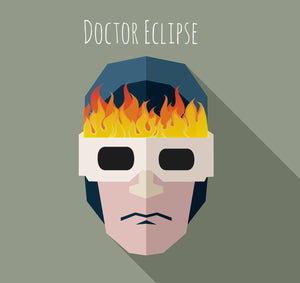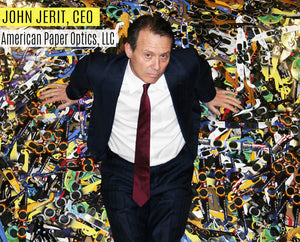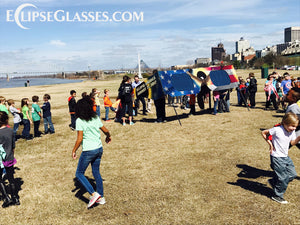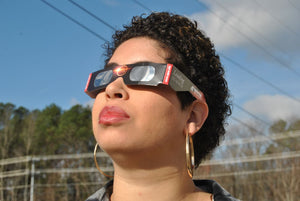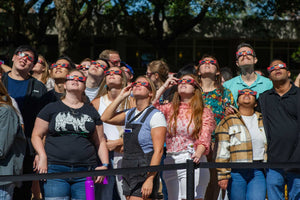Blog
Six months to prepare for a rare total solar eclipse to cross the U.S.

MEMPHIS, Tenn., Feb. 21, 2017 – On Aug. 21, 2017, millions of people across 12 states, stretching from Oregon to South Carolina, will witness a total solar eclipse, a rare event that last happened 38 years ago. The remaining 38 states of the U.S. will be able to view a partial eclipse.
In order to safely experience the event, everyone across the country will need safe solar eclipse glasses. American Paper Optics, the largest 3-D glasses manufacturing company in the world, plans to work around the clock to make sure people are prepared for what could be a once-in-a-lifetime opportunity.
“With the total solar eclipse just six months away, everyone needs to start planning,” said John Jerit, president and CEO of APO. “We’re advising people to figure out where they will be (or where they want to be) on Aug. 21, 2017, and more importantly, make sure they have safe solar eclipse glasses ready.”
APO’s Eclipser® Safe Solar Glasses are ISO certified to block the harmful ultraviolet and infrared rays of light that come from the sun. The glasses, which are 1,000 times darker than regular sunglasses, are the safest way to view the eclipse.
“For at least a couple of minutes on Aug. 21, 2017, people across the country will stop what they are doing and look up to the sky to view the sun,” said Jason Lewin, director of marketing at APO. “This historic opportunity – one we feel is bigger than any sporting event, concert or awards show - is something that companies and organizations of all sizes can participate in at a very inexpensive cost. Now is the time to order safe solar eclipse glasses.”
APO expects to sell 100 million eclipse glasses for the solar eclipse. For the last year, Jerit has talked with corporations and organizations across the U.S., from universities to CVBs and Fortune 500 companies to small businesses that want to capitalize on the event for their customers and employees. The glasses can be custom-branded for any company or organization – using size, shape and color scheme – to promote the business.
For more information and to purchase Eclipser Safe Solar Glasses, call 1-800-767-8427
About American Paper Optics
American Paper Optics, the world’s leading manufacturer and marketer of solar eclipse and 3-D glasses as well as other optical products, is a one-stop source for anything 3-D. Over a span of 25 years, APO has manufactured more than two billion paper 3-D glasses. APO also offers an endless variety of frame styles, specialty optics, full color printing, and intricate die-cutting capabilities.
- Jason Lewin
Entrepreneur not ‘eclipsed’ by diagnosis
CEO's goal of 100,000,000 glasses lives on after winning battle with cancer

There’s no good time to learn that your new reality consists of one of the scariest words known to man – cancer. But John Jerit received this news at what he now considers to have been the worst time. Less than two years out from an event that he has literally been waiting for his entire life, John was shocked to hear that his annual prostate screening uncovered cancerous cells.
As of December 2015, life for John would never be the same.
But, this life-altering moment didn’t create the kind of bone-chilling fear one would assume hits when you learn of your own cancer diagnosis. In fact, John admits he was only moderately concerned about how the cancer would affect his health, family and finances. On the contrary, when he learned that cancer was now part of his life story, John’s thoughts turned to Aug. 21, 2017. This date marks the first time since 1979 that the U.S. will experience a total solar eclipse…and John planned to live to witness it, one way or another.
As owner and CEO of American Paper Optics, the largest manufacturer of 3D and safe solar eclipse glasses in the world, John’s career dream has been to personally view and make sure that every American is afforded the opportunity to safely view this eclipse. In February 2016, John’s dream slowly morphed into a strong possibility as he successfully underwent robotic surgery. Then, as he started down his road to recovery, John became more and more inspired to get eclipse glasses in the hands of as many people as possible.
John wanted people across the country to understand that no matter where they are geographically located on Aug. 21, they’ll need to wear the CE and ISO-certified glasses that APO makes to safely view the eclipse. The glasses, which are close to 1,000 times darker than regular sunglasses, are THE safest way to view the solar eclipse because they filter out 100% of harmful ultra-violet and infrared rays and 99.999% of intense visible light. Additionally, the glasses can be custom branded to fit any company’s design preferences.
John’s post-cancer inspiration led to him setting a goal to sell 100,000,000 glasses before Aug. 21, 2017. Of course, this was met with much skepticism. Some said it was unattainable. Some said it was unrealistic. Some said he was just crazy. Despite it all, John maintained the thinking that if he could beat cancer, he could reach his goal. After all, American Paper Optics did manufacture 134,000,000 3D glasses in 2009 for two Super Bowl commercials.
Today, John is cancer free and aggressively working toward his goal. To date, APO has manufactured glasses for several convention and visitors bureaus, hotels, museums, schools and NASA. Additionally, the company is working closely with several retail chains to distribute eclipse glasses. John says he knows he has a long way to go. However, he’s confident that his passion and company track record, combined with the curiosity from consumers to discover their “inner scientist” during what’s shaping up to be the largest sky event in history,” will help his dream come true – one pair of eclipse glasses at a time.
- Jason Lewin
Creating Eclipse Awareness Through Record Breaking Glasses
APO Builds World Record Sized Glasses

On Aug. 21 of this year, people in the United States, coast-to-coast, will be treated to a total solar eclipse. This will be the first eclipse visible from the continental United States in nearly four decades and the first where totality lies completely within the US since 1776. Talk about a huge event!
To commemorate this massive occasion, American Paper Optics, the world’s largest 3D optics company, has created the largest pair of functioning eclipse glasses in the world. These glasses, measuring over 32 feet wide and over 3 feet tall. This world record size construction was built so that people can stand behind the glasses and safely look up at the sun in the same way they would with regular size safe solar eclipse glasses.
“We wanted to do something completely different to show how big of an event this actually is,” said John Jerit, president and CEO of American Paper Optics. "It's finally our turn [in the US] to witness history and we wanted to create awareness the only way we know how- by creating the world’s largest pair of eclipse glasses. What's exciting about this event is that the only thing you really need to be prepared is a pair of our (regular size) safe solar eclipse glasses," said Jerit. "This is a rare opportunity for hundreds of millions of people to see something they’ve never seen before, so we're encouraging everyone to get their glasses now so they are properly prepared.”

Since the company originated in 1990, American Paper Optics has become the world leader in manufacturing paper 3D glasses. Founder, John Jerit, transformed a novelty start-up business into a 3D glasses empire with multimedia products distributed worldwide. Jerit attributes aggressive marketing and customer loyalty to the company's successful production and distribution of more than two billion glasses. With a long and proven track record for high quality products, American Paper Optics has established itself as THE “go to” manufacturer for the upcoming August eclipse.
“We set out with the idea to build something absolutely enormous to reflect the magnitude of this upcoming event. Think about it, on August 21st, the entire country will stop whatever they are doing to take in this one moment and they will all need eclipse glasses," said Jason Lewin, director of marketing at APO. "While the excitement continues to grow about the upcoming eclipse, we definitely want people to be safe. Our low-cost eclipse glasses will allow viewers to witness this event with the peace of mind that they have put safety first."
We built these fun eclipse glasses to create awareness for the August event. We would love for you to help us in this process by sharing our story. The more that know, the safer everyone will be! Please call us for more information at 1-800-767-8427
- Jason Lewin
- Tags: Eclipse Glasses
Are You Ready For The 2017 Solar Eclipse?
During Earth's history, a wide variety of amazing events has been seen in our skies. Of these, probably the most remarkable event and the one that always draws a large amount of attention and speculation is the solar eclipse. This is what occurs when the moon passes over and completely blocks out the sun. We are extremely lucky to be able to see a 2017 solar eclipse because the distances between our moon and the sun mean that they look the same size in our sky. On August 21st, 2017, you can witness this event for yourself and experience what has astounded and mesmerized human beings for thousands of years.
- Jason Lewin
Make Life-Long Memories With Eclipse Shades
Have you ever had the opportunity to witness a solar eclipse? In this day and age, with the Internet, you most likely have been able to see videos of solar eclipses that have been visible in other countries.
- Jason Lewin
